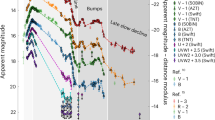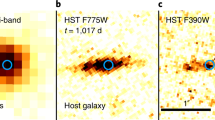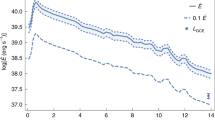Abstract
The extremely luminous supernova SN 2006gy (ref. 1) challenges the traditional view that the collapse of a stellar core is the only mechanism by which a massive star makes a supernova, because it seems too luminous by more than a factor of ten. Here we report that the brightest supernovae in the modern Universe arise from collisions between shells of matter ejected by massive stars that undergo an interior instability arising from the production of electron–positron pairs2. This ‘pair instability’ leads to explosive burning that is insufficient to unbind the star, but ejects many solar masses of the envelope. After the first explosion, the remaining core contracts and searches for a stable burning state. When the next explosion occurs, several solar masses of material are again ejected, which collide with the earlier ejecta. This collision can radiate 1050 erg of light, about a factor of ten more than an ordinary supernova. Our model is in good agreement with the observed light curve for SN 2006gy and also shows that some massive stars can produce more than one supernova-like outburst.
This is a preview of subscription content, access via your institution
Access options
Subscribe to this journal
Receive 51 print issues and online access
$199.00 per year
only $3.90 per issue
Buy this article
- Purchase on Springer Link
- Instant access to full article PDF
Prices may be subject to local taxes which are calculated during checkout



Similar content being viewed by others
References
Smith, N. et al. SN 2006gy: discovery of the most luminous supernova ever recorded, powered by the death of an extremely massive star like Eta Carinae. Astrophys. J. 666, 1116–1128 (2007)
Barkat, Z., Rakavy, G. & Sack, N. Dynamics of supernova explosions resulting from pair formation. Phys. Rev. Lett. 18, 379–381 (1967)
Woosley, S. E., Heger, A. & Weaver, T. A. The evolution and explosion of massive stars. Rev. Mod. Phys. 74, 1015–1071 (2002)
Figer, D. F. An upper limit to the masses of stars. Nature 434, 192–194 (2005)
Vink, J. S. & de Koter, A. Predictions of variable mass loss for Luminous Blue Variables. Astron. Astrophys. 393, 543–553 (2002)
Smith, N. & Owocki, S. P. On the role of continuum-driven eruptions in the evolution of very massive stars and population III stars. Astrophys. J. Lett. 645, L45–L48 (2006)
Smith, N. Eruptive mass loss in very massive stars and population III stars. In Massive Stars: From Pop III and GRBs to the Milky Way (in the press); preprint at 〈http://arxiv.org/abs/astro-ph/0607457v2〉 (2006)
Vink, J. S. & de Koter, A. On the metallicity dependence of Wolf-Rayet wind. Astron. Astrophys. 442, 587–596 (2005)
Kudritzki, R. P. Line-driven winds, ionizing fluxes, and ultraviolet spectra of hot stars at extremely low metallicity. I. Very massive O stars. Astrophys. J. 577, 389–408 (2002)
Woosley, S. E. & Weaver, T. A. In Radiation Hydrodynamics in Stars and Compact Objects (eds Mihalas, D. & Winkler, K.-H. A.) Lecture Notes Phys.. 255, 91–120 (1986)
Heger, A. & Woosley, S. E. The nucleosynthetic signature of population III. Astrophys. J. 567, 532–543 (2002)
Woosley, S. E. & Weaver, T. A. In Supernovae: A Survey of Current Resarch (eds Rees, M. J. & Stoneham, R. J.) NATO Advanced Study Inst. Ser. 90, 79–99 (1982)
Bond, J. R., Arnett, W. D. & Carr, B. The evolution and fate of very massive objects. Astrophys. J. 280, 825–847 (1984)
Weaver, T. A., Zimmerman, G. B. & Woosley, S. E. Presupernova evolution of massive stars. Astrophys. J. 225, 1021–1029 (1978)
de Jager, C., Nieuwenhuijzen, H. & van der Hucht, K. A. Mass loss rates in the Hertzsprung-Russell diagram. Astron. Astrophys. 72 (Suppl.). 259–289 (1988)
Nieuwenhuijzen, H. & de Jager, C. Parametrization of stellar rates of mass loss as functions of the fundamental stellar parameters M, L, and R. Astron. Astrophys. 231, 134–136 (1990)
Grasberg, E. K. & Nadyozhin, D. K. Type-II supernovae—two successive explosions. Sov. Astron. Lett. 12, 68–70 (1986)
Blinnikov, S. I. et al. Theoretical light curves for deflagration models of type Ia supernova. Astron. Astrophys. 453, 229–240 (2006)
Chugai, N. N. et al. Type IIn supernova 1994W: evidence for the explosive ejection of a circumstellar envelope. Mon. Not. R. Astron. Soc. 352, 1213–1231 (2004)
Ofek, E. O. et al. SN 2006gy: An extremely luminous supernova in the galaxy NGC 1260. Astrophys. J. Lett. 659, L13–L16 (2007)
Scannapieco, E., Madau, P., Woosley, S. E., Heger, A. & Ferrara, A. The detectability of pair-production supernovae at z < 6. Astrophys. J. 633, 1031–1041 (2005)
Nomoto, K., Tominaga, N., Tanaka, M., Maeda, K. & Umeda, H. Nucleosynthesis in core-collapse supernovae and GRB-metal-poor star connection. In Supernova 1987A: 20 Years After: Supernovae and Gamma-Ray Bursters (eds Immler, S., Weiler, K. & McCray, R.) (American Institute of Physics, in the press); preprint at 〈http://arxiv.org/abs/0707.2187〉 (2007)
Umeda, H. & Nomoto, K. How much 56Ni can be produced in core-collapse supernovae? Evolution and explosion of 30–100 solar mass stars. Astrophys. J. (submitted); preprint at 〈http://arxiv.org/astro-ph07072598〉 (2007)
Heger, A., Woosley, S. E. & Spruit, H. Presupernova evolution ofdifferentially rotating massive stars including magnetic fields. Astrophys. J. 626, 350–363 (2005)
Duncan, R. C. & Thompson, C. Formation of very strongly magnetized neutron stars—Implications for gamma-ray bursts. Astrophys. J. 392, L9–L13 (1992)
Woosley, S. E. Gamma-ray bursts from stellar mass accretion disks around black holes. Astrophys. J. 405, 273–277 (1993)
Usov, V. V. Millisecond pulsars with extremely strong magnetic fields as a cosmological source of gamma-ray bursts. Nature 357, 472–474 (1992)
MacFadyen, A. I. & Woosley, S. E. Collapsars: gamma-ray bursts and explosions in “failed supernovae”. Astrophys. J. 524, 262–289 (1999)
Van Dyk, S. D., Filippenko, A. V., Chornock, R., Li, W. & Challis, P. M. Supernova 1954J (variable 12) in NGC 2403 unmasked. Publ. Astron. Soc. Pacif. 117, 553–562 (2005)
Foley, R. J. et al. 2006jc: a Wolf-Rayet star exploding in a dense He-rich circumstellar medium. Astrophys. J. 657, L105–L108 (2007)
Chevalier, R. A. & Blondin, J. M. Hydrodynamic instabilities in supernova remnants: early radiative cooling. Astrophys. J. 444, 312–317 (1995)
Acknowledgements
This work was supported by the Scientific Discovery through Advanced Computing (SciDAC) Program of the US Department of Energy, by NASA, and by the Russian Foundation for Basic Research and Science Schools. At Los Alamos, this work was carried out under the auspices of the National Nuclear Security Administration of the US Department of Energy.
Author Contributions S.E.W. and A.H. proposed that the light curves of pulsational pair-instability supernovae might have a large range in luminosity including exceptionally brilliant supernovae. They carried out the calculations of stellar evolution and explosion. S.B. provided expertise in the physics of supernovae with circumstellar interaction and calculated all the light curves from the models except those done with Kepler.
Author information
Authors and Affiliations
Corresponding author
Ethics declarations
Competing interests
The authors declare no competing financial interests.
Supplementary information
Supplementary Information
This file contains Supplementary Figures S1 – S12 with Legends and Supplementary Table 1. The figures show the evolution of the composition through the two outbursts, the bolometric light curve of the two bursts, the multicolor photometry of models in which the density and explosion energy are varied, and other details of the emission. The table presents a summary of results for other similar mass stars with highly variable explosion properties. (PDF 333 kb)
Rights and permissions
About this article
Cite this article
Woosley, S., Blinnikov, S. & Heger, A. Pulsational pair instability as an explanation for the most luminous supernovae. Nature 450, 390–392 (2007). https://doi.org/10.1038/nature06333
Received:
Accepted:
Published:
Issue Date:
DOI: https://doi.org/10.1038/nature06333
This article is cited by
-
Contribution of population III stars to merging binary black holes
Reviews of Modern Plasma Physics (2024)
-
Science with the 2.5-meter Wide Field Survey Telescope (WFST)
Science China Physics, Mechanics & Astronomy (2023)
-
Thermonuclear Explosions of Pair-Instability Supernovae Induced by Electron–Positron Pairs and Neutrinos
Brazilian Journal of Physics (2022)
-
Hierarchical mergers of stellar-mass black holes and their gravitational-wave signatures
Nature Astronomy (2021)
-
Modeling the outcome of supernova explosions in binary population synthesis using the stellar compactness
Rendiconti Lincei. Scienze Fisiche e Naturali (2021)
Comments
By submitting a comment you agree to abide by our Terms and Community Guidelines. If you find something abusive or that does not comply with our terms or guidelines please flag it as inappropriate.



